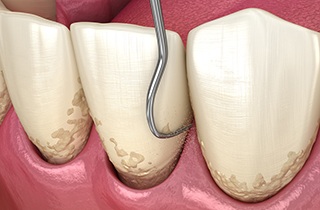Gum Disease Treatment – DFW Metroplex
Dealing With Your Gums’ Infection

Though teeth are crucial to oral health, gums are just as important; these tissues cause many issues when they get inflamed or infected. Thankfully, Bear Creek Family Dentistry offers gum disease treatment in the DFW Metroplex. We'll gladly heal your damaged gums, ensuring they keep your smile strong and safe! Our team will even share the relevant details on how that process works. So, please keep reading or book your visit to our office today!
Why Choose Bear Creek Family Dentistry for Gum Disease Treatment?
- Experienced & Skilled Dental Hygienists
- Rest & Relax During Treatment
- Dental Insurance Accepted
What is Gum Disease?

In essence, gum disease is an infection of your gums – the soft mouth tissues around your teeth. The condition often stems from plaque buildup, usually due to poor eating, bad oral care, etc. Other factors like genetics, hormones, and tobacco use can also make it likely to occur.
Gum disease has two stages of progression: gingivitis and periodontitis. The first refers to mild gum inflammation, which is often irritating but not severe. Meanwhile, the second stage – periodontitis – is a full-blown infection that attacks jaw and gum tissue. While gingivitis can be reversed with good oral care, periodontitis can only be managed.
Symptoms of Gum Disease

Since gum disease has two distinct stages, it can cause a wide range of symptoms. Which signs you show will depend on your infection’s severity, progress, etc.
For example, consider a case of gingivitis. This early form of gum disease has (relatively) mild symptoms, including:
- Chronic bad breath (i.e., halitosis)
- Gum tenderness
- Swollen gums
- Red, bleeding gums
- Gum recession
On the other hand, periodontitis has fairly harsh symptoms that make big impacts. The most common of these are:
- A shift in your bite
- Changes in your restoration’s fit
- Tooth sensitivity (often due to gum recession)
- Chewing pain
- Loose permanent teeth
- Permanent tooth loss
How Do We Treat Gum Disease?

Before we settle your treatment options, one of our dentists will give you a thorough oral exam. Doing so lets us check the overall severity of your gum disease. Once the dentist settles their findings, they’ll then suggest possible procedures like:
Scaling and Root Planing

Often viewed as the traditional solution for gum disease, scaling and root planing is a two-step deep cleaning of your gums. It involves carefully removing built-up plaque and tartar that becomes trapped under the gums, in places where your toothbrush cannot reach. This treatment serves a two-fold purpose; it’s meant to totally halt the progression of advanced gum disease that’s caused by these hidden, harmful bacteria, but just as importantly, it helps to prevent future infection.
Do You Need Scaling & Root Planing?

Our team will recommend scaling and root planing if your gum disease has progressed passed the point where improved at-home oral hygiene can halt it. You might need this form of treatment if you notice any symptoms such as:
- Bleeding when brushing or flossing
- Swollen or puffy gums
- Receding gums
- Persistent bad breath
- Constant foul taste
- Shifting teeth
- Difficulty biting and chewing
- Visible plaque buildup
The Process of Scaling & Root Planing

In many cases, the scaling and root planing process is performed over the course of two appointments, depending on the severity of the case. Rest assured, your mouth is adequately numbed before we get started. First, our team will use specialized tools to carefully, gently remove any built-up plaque and bacteria that are trapped in deep pockets beneath the gum line.
These bacteria cannot be removed on your own with good dental hygiene habits, and unless they’re eliminated, your gum disease will only worsen. Once these bacteria have been fully removed, the roots of the teeth can then be smoothed so that the surrounding gum tissue can begin healing and reattaching itself. This makes it more difficult for bacteria to become trapped again in the future.
Aftercare Tips for Scaling & Root Planing

Since your mouth will be numbed prior to scaling and root planing, you will have to deal with some residual numbness following your treatment. It’s recommended that you avoid eating for at least two hours after your procedure, since you could accidentally bite your tongue or cheeks. For the next several days, rinse with saltwater every few hours. You can still brush as you normally would, using gentle, slow, circular motions, but be careful near the treated area. When you finally feel like eating, avoid anything hot or spicy, and avoid using tobacco products or smoking. It’s also wise to refrain from intense physical activity for at least the first day or two.
